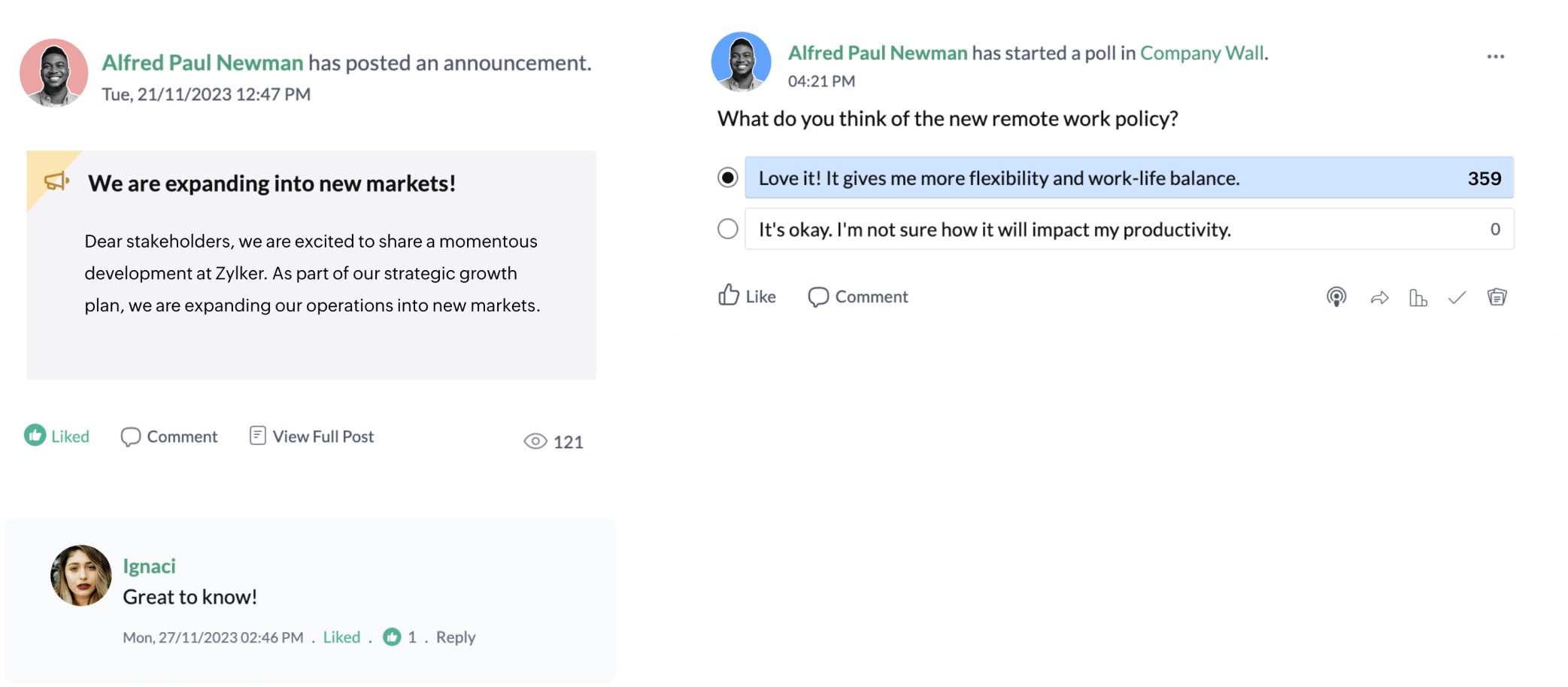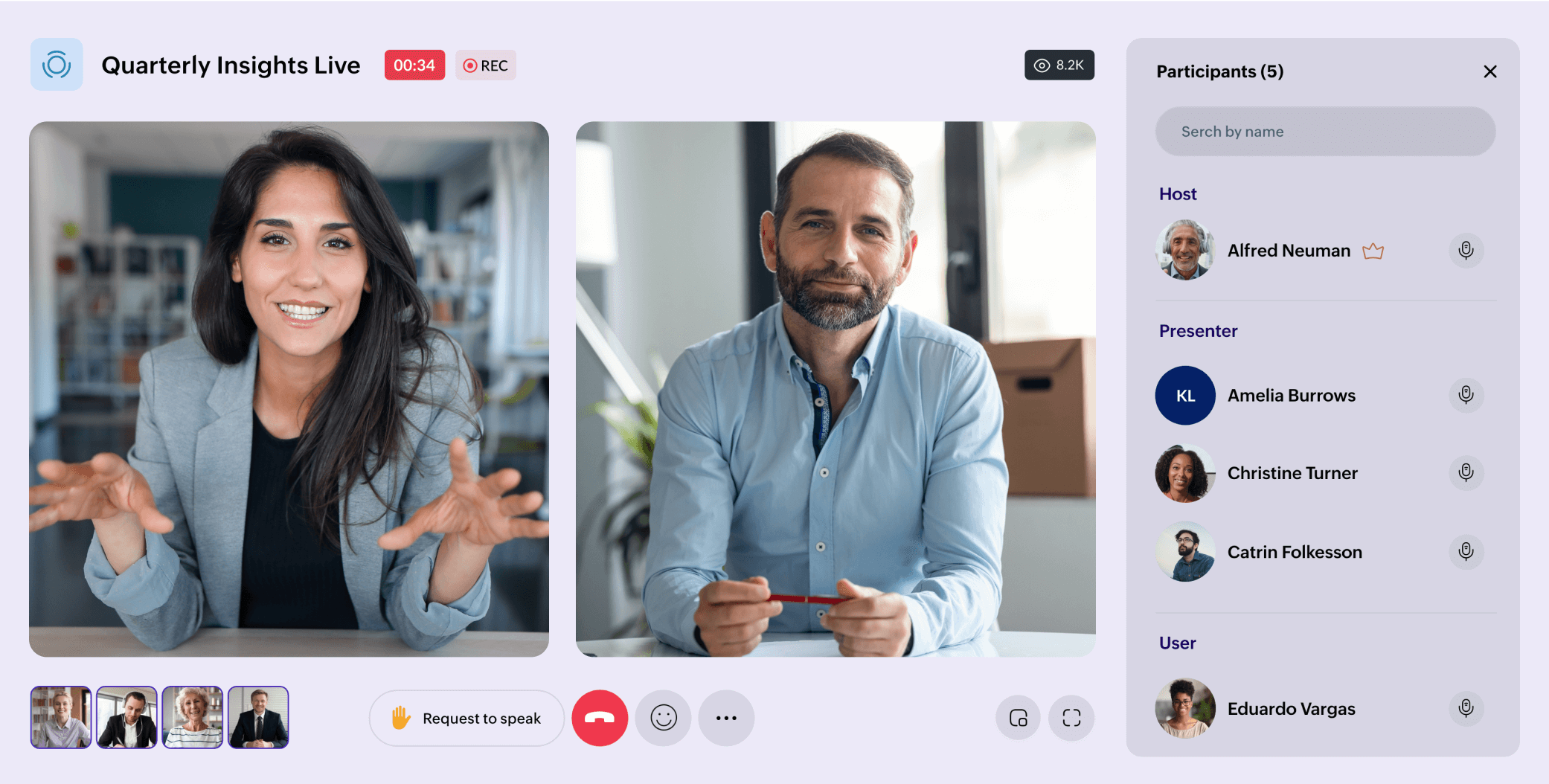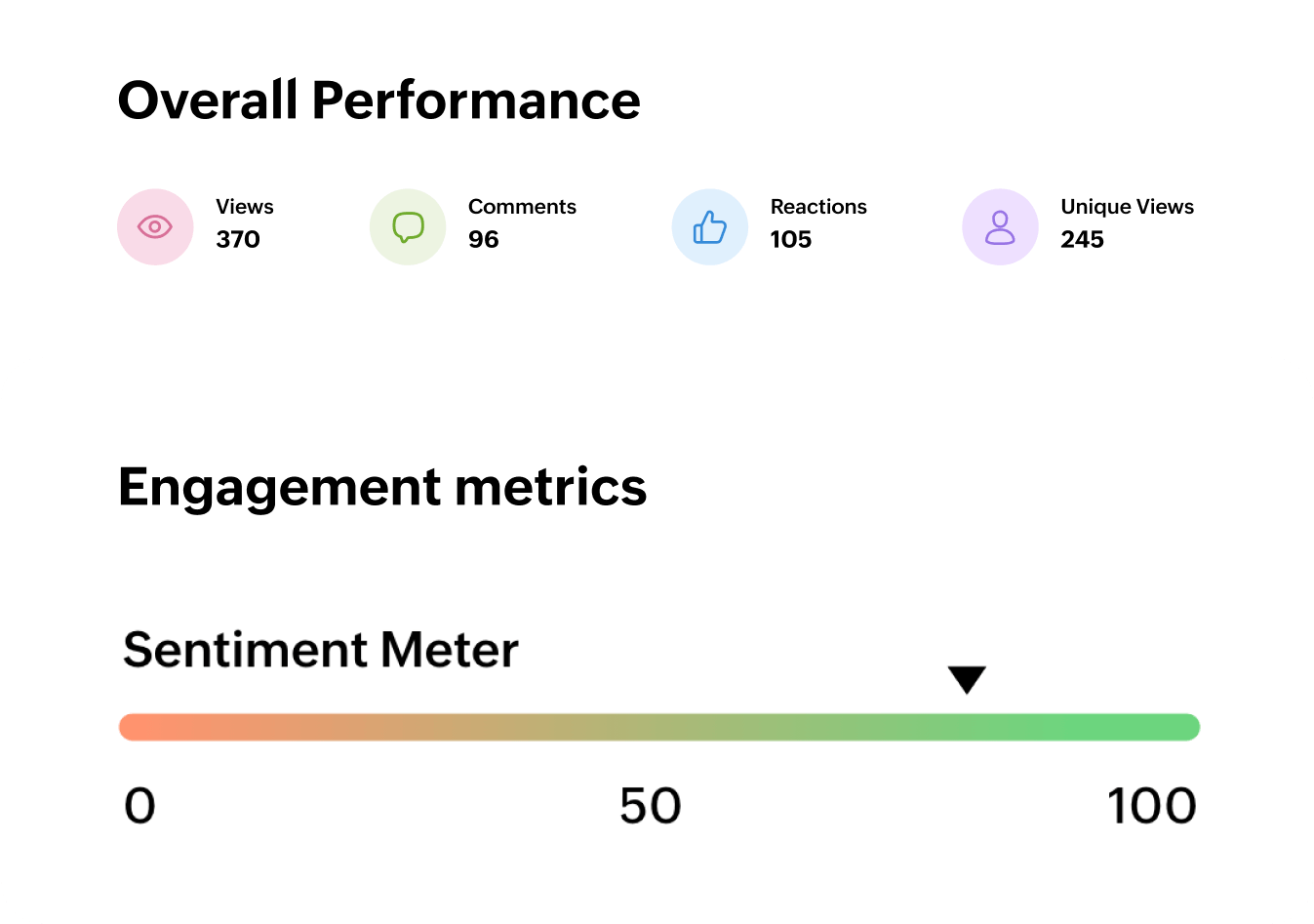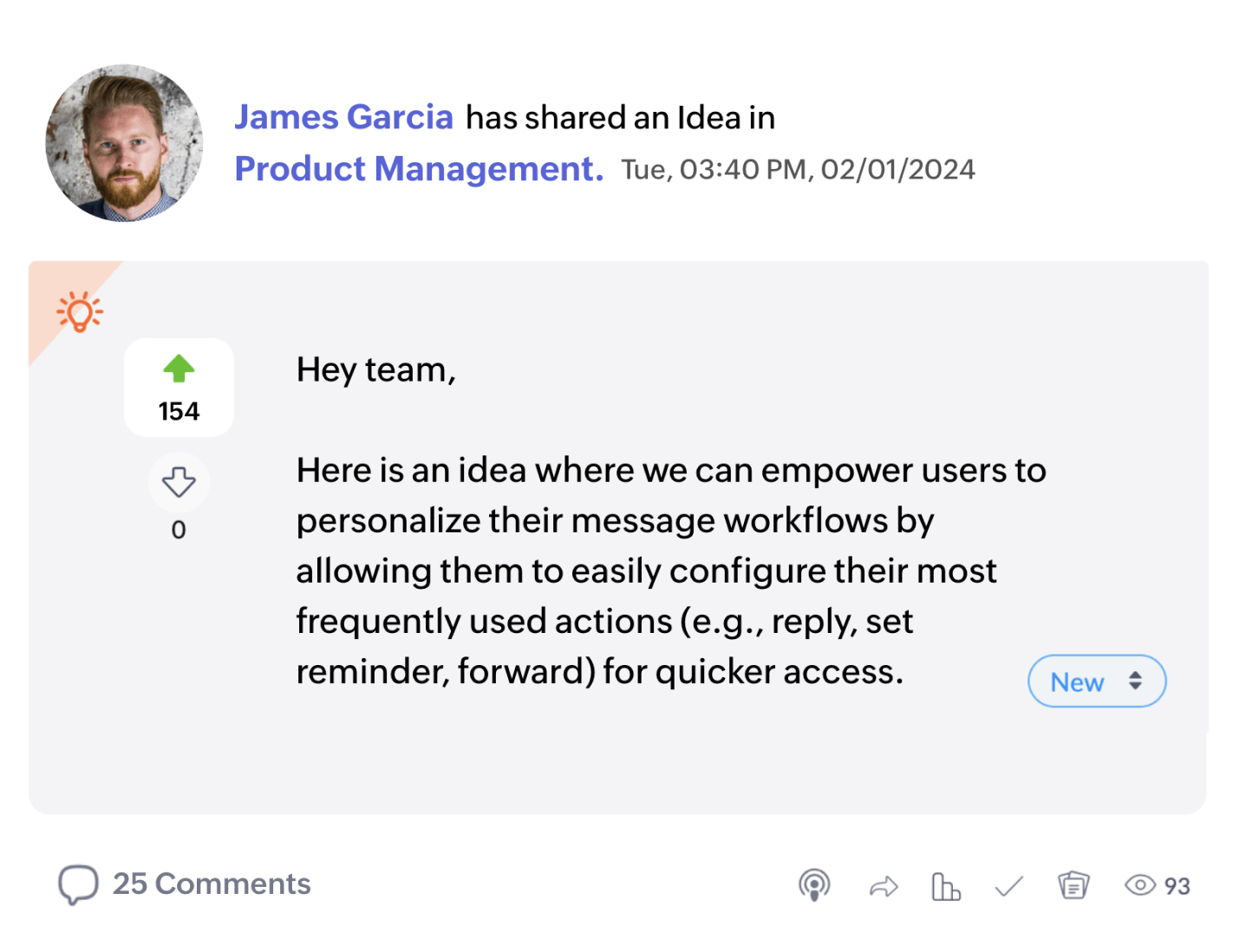Employee engagement a comprehensive guide
Improve workplace morale and elevate your organization’s employee engagement.
Free for 15 days
No credit card required


What is employee engagement?
Employee engagement refers to the drive, connection, and dedication employees feel towards their jobs, the organization, and its values. It’s a crucial factor in keeping employees satisfied and happy at the workplace.

Why is employee engagement important?
23%
increase in profitability
Organizational success depends on the ability to keep customers happy. To enhance customer happiness, businesses need to focus on keeping their employees engaged. A higher rate of employee engagement fosters a culture of innovation and positivity, motivating everyone to give their best and align themselves towards the organization’s vision. Studies have shown that simply having highly engaged employees can bring a 23% increase in profitability, directly impacting the growth and success of any organization.
What are the drivers for employee engagement?
Here are the main factors that have a direct impact on employee engagement.
Purpose
Employees need to know they’re part of something bigger than themselves, that their work is meaningful and has a positive impact.
Learning and growth
Work needs to be interesting, challenging, and provide opportunities for employees to skill up and grow in their careers.
Empathetic leadership
Leaders across all levels need to be kind, respectful of employees’ boundaries, and treat everyone equally.
Connection
Employees should be given the space to network and get to know like-minded coworkers, exchange ideas, and build bonds over shared interests.
Regular feedback
Knowing where they stand, and how they can improve, and being recognized for their wins, big or small, is necessary for employees to continue giving their best.
Positive work culture
An environment that is conducive to learning, sharing, growth, respect, openness, and a sense of belonging drives employees to value the organization beyond pay checks and benefits.
What are the benefits of increased employee engagement?
More focused employees
When employees are engaged, they’re invested in contributing towards the company’s goals, and they devote their efforts to it.
Higher productivity
Employees who go the extra mile and contribute creative ideas are often the most engaged employees.
Healthy work culture
A culture that values employee contributions, recognizes their efforts, and proactively earns their commitment is one that attracts the best talent.
Employee satisfaction
Employees need a sense of community at work to feel happy; they need to learn, grow, form connections, and bond over shared interests—not just keep working nonstop.
Better customer service
It’s well-accepted that to take good care of customers, companies need to prioritize their employees. After all, happy employees create happy customer experiences.
Begin your journey, level up employee engagement.

How can organizations improve employee engagement?
Employee engagement is often deemed as a HR thing, meaning only HR should be responsible for improving the rate of engagement. While HR plays a major role, so does company leadership and, in particular, team leadership. HR may not always be in a position to ensure that employees keep a positive attitude on a team level. Many employees turn to their managers or mentors for support and feedback, which makes managers ideally placed to understand how invested employees are in the organization on a regular basis.
Ensuring high levels of employee engagement is a collective responsibility. Organizations need management that’s willing to invest in employees, HR that sets the overall approach and makes work environments friendly and safe, and managers who motivate and understand their team. The foundation for all of this lies in strengthening communications, improving transparency, and building trust.
Here's what organizations can do:
Connect employees to the overall purpose
Employees need to know what the company stands for, its values, and vision. This gives them a sense of direction and aids them in planning their careers.
Make work less stressful
Work takes precedence, but it's important not to overwhelm employees with unrealistic expectations. Break down work into practical trackable goals and be open to ideas.
Recognize employee contributions
Make sure that employees are rewarded for the work they do. This tells them that their work matters and motivates them to give their best.
Train managers and leaders
Ensure that anyone in a leadership position receives training on the importance of engagement, inter-personal skills, and exercising empathy towards employees.
Grant employees autonomy
Allow employees to take responsibility by giving them freedom to make decisions within the scope of their work. Tedious processes for approvals wear everyone down.
Support learning and growth
Provide opportunities for employees to develop new skills and move further in their careers. Assign mentors or allow subject matter experts to share their knowledge.
Check in on all employees
From your newest employee to seasoned managers, HR, and the company leadership, make sure your workforce is feeling positive. Understanding the company’s pulse helps identify where the gaps are.
How can employee engagement solutions like Zoho Connect help?
With teams being distributed across the globe, and with employees following multiple modes of work, we need technology to help us truly unite and engage all employees.
As a leading employee experience (EX) platform, one of the primary functions of Zoho Connect is boosting employee engagement. Here’s how the platform can help:
With company walls, feeds, all-hands groups, and announcements, make sure all employees are aware of what’s happening in the company. Whether it’s an event or a new business deal, keep employees invested.

Host town halls or live broadcast sessions with the CEO and management to improve leadership engagement and build trust through regular interactions.

With our built-in peer-to-peer recognition, send badges to each other and acknowledge wins, big or small, creating a culture of appreciation and gratitude.

Get to know what employees feel about an announcement or any company news you’ve shared through sentiment analysis. View the sentiment meter to see if the reactions are positive, negative, or neutral, and track the engagement score.

With employee surveys, regularly gauge how everyone in your organization is doing. Pick from our list of templates or create your own with our simple builder.

Incentivize employee interactions through gamification. Assign points for activities such as sharing a post, or asking a town hall question, or adding a comment, to allow employees to engage themselves and have fun.

Empower employees to share ideas with a dedicated idea-sharing space. Foster creativity and innovation by encouraging ideas across hierarchies and giving employees the space to upvote the best ones.

Keep all your employees engaged and happy.

The relationship between engagement and employee retention
When employees are engaged, workplace morale automatically improves. Employees who find purpose in their work are more likely to stay in the organization. When companies can retain their top talent, they innovate better and can sustain profitability in the long run. The opposite happens when companies ignore employee engagement: Employees become disgruntled and leave the organization, institutional knowledge is lost, and the company gets a bad reputation. When attrition rates are high, costs increase, and progress is hindered.
Employee engagement platforms are crucial for organizational success. Whether it’s frontline employees, knowledge workers, or in-office employees, it’s essential for organizations to have a common platform accessible to everyone, to interact, ideate, and experience the culture.
When employees grow and stay invested in the company’s values, businesses become successful.
Get a head start by signing up for an employee engagement solution today.
Free for 15 days
No credit card required
Looking to learn more about employee engagement?
Get started with our articles.









